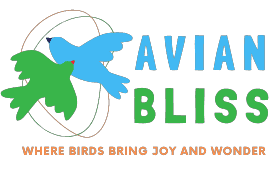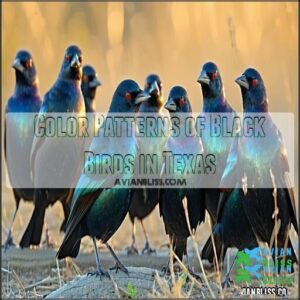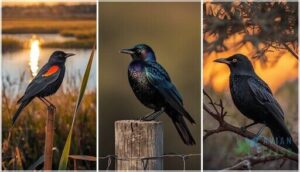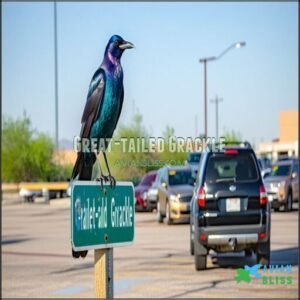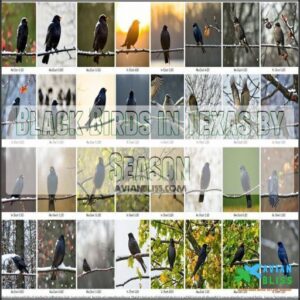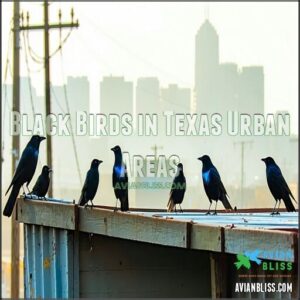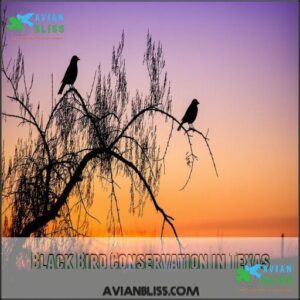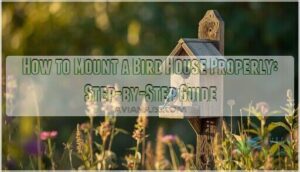This site is supported by our readers. We may earn a commission, at no cost to you, if you purchase through links.
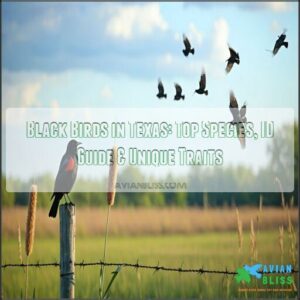
Common species include the Red-winged Blackbird, with its bright red shoulder patches, and the Great-tailed Grackle, known for its bold personality and loud calls.
You’ll also spot European Starlings, easily recognized by their glossy feathers that shimmer with hints of green and purple.
These birds thrive in diverse habitats, from city parks and backyards to open fields and wetlands.
Their diets range from insects and seeds to leftover crumbs, making them resourceful and adaptable.
Want to attract them? Provide food, water, and native plants, and you’ll have winged visitors in no time!
Table Of Contents
- Key Takeaways
- Types of Black Birds in Texas
- Identifying Black Birds in Texas
- Behavior and Habitat of Black Birds
- Attracting Black Birds to Your Backyard
- Most Common Black Birds in Texas
- Black Birds in Texas by Season
- Black Birds in Texas Urban Areas
- Black Bird Conservation in Texas
- Black Bird Diet and Nutrition
- Interesting Facts About Black Birds in Texas
- Frequently Asked Questions (FAQs)
- Are there Blackbirds in Texas?
- What birds are black in Texas?
- What does a blackbird look like in Texas?
- Are red-winged blackbirds common in Texas?
- Is there a more beautiful black bird in Texas?
- Why doesn’t Texas have any endemic birds?
- Are grackles good or bad birds?
- What’s the difference between a crow and a grackle?
- Are blackbirds good to be in your yard?
- How do you identify a blackbird in Texas?
- Conclusion
Key Takeaways
- You’ll find diverse black birds in Texas like Great-tailed Grackles, Red-winged Blackbirds, and European Starlings thriving in urban areas, wetlands, and grasslands.
- Watch for unique traits like iridescent plumage, bold red shoulder patches, and yellow eyes that make bird identification fun and rewarding.
- Attract black birds to your yard with native plants, fresh water, and foods like sunflower seeds, fruits, and suet, especially in winter.
- Help conservation by reducing pesticides, planting native shrubs, and supporting organizations that protect bird habitats and migratory paths.
Types of Black Birds in Texas
You’ll find a fascinating variety of black birds in Texas, from common species in city parks to rare ones in wetlands.
Each bird has unique traits, making identification an exciting challenge for birdwatchers.
Common Black Birds Found in Texas
Ever wondered what black bird species you’re most likely to see in Texas?
These common black birds add energy to the state’s vibrant habitats, from city parks to open wetlands.
Here are five fascinating ones to watch for:
- Great-tailed Grackle: Their shimmering feathers and long tails make them a showstopper, especially in parking lots.
- Common Grackle: With sharp yellow eyes, they’re bold and curious, often spotted in urban areas.
- Red-winged Blackbird: Their striking red-and-yellow shoulders stand out in Texas marshes.
- American Crow: Intelligent and shiny black, they’re nature’s clever problem-solvers.
- European Starling: Known for murmurations, their glossy plumage dazzles in sunlight.
Keep an eye out for these Texas blackbirds!
Rare Black Birds Spotted in Texas
Rare black birds in Texas are a fantastic find for birders, offering exciting opportunities for Texas bird watching and bird identification.
Exploring rare black birds in Texas adds wonder to birdwatching, turning each sighting into a unique and unforgettable adventure.
These species add a touch of wonder to your sightings:
- Rusty Blackbird: Facing a population decline, these wetland lovers appear in Texas swamps during migration.
- Southern Lapwing: A rare visitor, spotted for the first time in a Texas golf course!
- Anhinga: Found in marshes and reservoirs, they use their snake-like necks to spear fish underwater.
Discover these black birds in Texas, truly rare species to cherish!
Black Birds With Unique Characteristics in Texas
Some black birds in Texas are impossible to overlook, each with unique features that turn heads.
Their traits make birdwatching unforgettable!
- Great-tailed Grackles: Boast long, iridescent plumage, their glossy tails shimmering in the sun.
- Red-winged Blackbirds: Flash fiery red-and-yellow “epaulets” during flight.
- European Starlings: Known for vocal mimicry, these birds mimic sounds beautifully.
- Brown-headed Cowbirds: Masters of brood parasitism, laying eggs in others’ nests.
- Common Grackles: Large black birds with piercing yellow eyes and distinct calls.
Perfect for bird identification in Texas!
Identifying Black Birds in Texas
You can identify black birds in Texas by observing their size, shape, and distinct color patterns.
Pay attention to their habitats too, as some prefer marshes while others stick to urban areas or open fields.
Size and Shape of Black Birds in Texas
When identifying black birds in Texas, focus on their relative size and unique features like bill shape, tail length, and body mass.
For instance, a Red-winged Blackbird has a sleek, compact frame with a conical bill, whereas a Great-tailed Grackle stands out with its sturdy build, long tail, and slender beak.
Their wing spans also differ—red-wings measure 12.6-14.2 inches, while grackles span up to 18.9 inches.
Noticing these details can feel like solving a mystery, but it’s key to mastering bird identification in Texas, which requires unique features to determine the species, and by doing so, you can find out which one’s in your yard today.
Color Patterns of Black Birds in Texas
In the context of spotting black birds in Texas, their color patterns are like nature’s fingerprint.
These variations can make bird identification in Texas exciting and rewarding.
- Iridescent Plumage: Male blackbirds often sparkle with purple, green, or blue tones under sunlight, giving them a dazzling, gem-like quality.
- Seasonal Variation: Rusty Blackbirds stand out with reddish-tipped feathers in fall, a unique seasonal look.
- Regional Differences: Females and juveniles bring subtle browns, streaks, and muted yellows. Beak shades or eye rings help distinguish species—perfect for tracking common black birds or uncovering rare appearances.
Habitat Preferences of Black Birds in Texas
Texas’s black birds thrive across the state’s rich landscapes, each offering unique resources for survival.
Black bird habitat preferences include Marsh Habitats and scattered wetlands, full of insects and perfect Nesting Sites.
Urban Adaptations bring them into parks and backyards, while the Gulf Coast’s Coastal Regions offer prime Foraging Areas.
Freshwater lakes and ponds provide hunting grounds, and open Grasslands support massive flocks.
- Marsh Habitats: Insect-rich zones for nesting.
- Urban Adaptations: Backyards and parks attract visitors.
- Coastal Regions: Abundant food sources prevail.
- Freshwater Sites: Rich fishing grounds.
- Grasslands: Seeds galore and wide vistas.
Behavior and Habitat of Black Birds
You’ll notice black birds in Texas thrive in varied habitats, from marshes to city parks, adapting well to their surroundings.
Their behaviors range from forming large noisy flocks to expertly foraging for seeds, insects, and even leftovers, showcasing their ability to thrive.
Migratory Patterns of Black Birds in Texas
When it’s Texas migration season, keep your eyes glued to the skies. Black bird migration showcases dynamic movements along major Flyway Routes. Red-winged Blackbirds, for example, flock to Stopover Habitats, thriving in wetlands and grassy areas.
Migration Triggers like daylight changes and food availability send them toward warmer Wintering Grounds across the state. Birds navigate using visual landmarks like rivers and coastlines.
Here’s a quick snapshot:
| Species | Migration Months | Habitat Preferences | Key Locations | Climate Impacts |
|---|---|---|---|---|
| Red-winged Blackbird | March to May | Marshes, grasslands | Statewide | Wetland habitat loss |
| Rusty Blackbird | October to March | Marshes, wet woodlands | Upper Texas Coast | Population in rapid decline |
| Yellow-headed Blackbird | April to May | Dense vegetation near water | North Texas | Affected by flooding patterns |
| Great-tailed Grackle | Year-round | Urban areas, farms | Central, South Texas | Adaptable to climate changes |
| Brewer’s Blackbird | Winter months | Open urban spaces | North, West Texas | Moderate environment impacts |
Texas connects migratory birds to entire hemispheres—a rhythmic wonder!
Social Behavior of Black Birds in Texas
You’ve probably seen massive bird flocks swirling in the sky—that’s Flocking Dynamics at its best.
These groups aren’t just for show; they protect members from predators while keeping an eye on food sources.
Their teamwork is anything but random.
What about Mating Rituals?
Breeding seasons bring elaborate displays: the Common Grackle performs bold movements, while the Great-tailed Grackle serenades with sharp whistles.
It’s nature’s version of a talent show!
Now, Territorial Defense is no joke.
These birds unite against threats, whether it’s a hawk or a nosy squirrel.
Common Habitats of Black Birds in Texas
In the context of bird habitats, black birds in Texas thrive in varied environments.
Wetland havens like marshes attract species such as Red-winged Blackbirds, while grassland roaming suits cowbirds and grackles.
Urban habitats, including city parks, golf courses, and backyard birds in Texas, offer easy feeding opportunities.
Coastal regions serve as migratory stops, while forest dwellers find shelter along wooded edges.
With Texas birding trails showcasing this diversity, it’s clear these adaptable birds anchor ecosystems, making bird watching here a truly rewarding experience.
Attracting Black Birds to Your Backyard
Attracting black birds to your backyard isn’t as tricky as it sounds. With the right food, water, and native plants, you can create a space they’ll enjoy year-round.
Best Food Options for Black Birds in Texas
If you’re looking to draw black birds to your backyard, offering the right snacks is the way to go.
Different species have unique appetites, but there are plenty of options to keep everyone happy at your bird feeders.
A well-rounded black bird diet includes seeds, fruits, insects, and more.
Black oil sunflower seeds are a favorite for many, while cracked corn is a budget-friendly staple they won’t turn down.
Got a sweet tooth?
Black birds do too—fresh berries and apple slices are a hit.
Suet choices are perfect for providing energy, especially in cooler months.
As for insect sources, mealworms are like candy for black birds.
You can even improve your chances by optimizing feeder placement.
Here are the top foods for backyard birds in Texas:
- Black oil sunflower seeds
- Fresh berries or apple chunks
- Suet blocks for energy
- Mealworms for protein
- Cracked corn for variety
Your yard’s about to get busy!
Water Sources for Black Birds in Texas
If you want to attract black birds in Texas to your yard, water is key.
Natural ponds, rivers, and wetlands are their favorite spots, providing hydration and a place to cool off.
But you don’t need a wetland in your backyard to welcome them!
A simple bird bath works wonders, giving them a safe spot to drink and splash around.
For extra appeal, add a shallow fountain.
Moving water keeps things fresh and also catches their attention—like rolling out the red carpet for your feathered guests!
Consider options for backyard bird hydration to enhance your space.
Rain collection systems are another great way to provide water, especially during Texas’ dry seasons.
Just remember to keep the water clean.
Left unattended, stagnant water can deter birds.
Whether you’re birding in Texas or just sprucing up your yard, these tips can turn your space into a watering hole for wildlife.
Plants and Trees That Attract Black Birds in Texas
To attract black birds in Texas, focus on planting a mix of native trees and shrubs that offer food, shelter, and nesting spots.
These plants create a natural buffet while beautifying your yard. Here’s what works best:
- Yaupon holly: This berry-producing shrub provides bright red berries blackbirds love during winter. It’s a backyard favorite for bird feeding.
- American beautyberry: Vibrant fruits on this native Texas plant attract blackbirds while supporting other backyard birds, too.
- Blackberry bushes: Sweet, juicy berries feed both birds and humans, making them irresistible to blackbirds.
- Texas wildflowers: These insect-attracting plants double as a snack source for black birds in Texas, especially during breeding season.
Add these seed-bearing and nesting habitat plants to create a lively, bird-friendly space. You can even purchase yaupon products to further support these plants.
Most Common Black Birds in Texas
You’ll find that black birds like the Red-winged Blackbird, European Starling, and Great-tailed Grackle are some of the most commonly spotted species in Texas.
These adaptable birds thrive in various habitats, from urban areas to wetlands, making them easy to observe no matter where you are, and they are found in a variety of habitats.
Red-winged Blackbird
The Red-winged Blackbird stands out among black birds in Texas, thanks to its vivid red and yellow shoulder patches.
A symbol of wetland biodiversity, you’ll often spot them in marshes and grasslands.
Males sing their signature "konk-a-reeee" to defend territory and attract mates.
Their nesting behavior depends on dense vegetation, offering protection for young.
These birds thrive on insect consumption, helping maintain Texas ecosystems.
Feather care is key for males to display vibrant plumage, essential for bird identification and breeding success.
Their striking colors and bird sounds add life to the state’s wetlands, making them unforgettable Texas Red-Wing residents.
European Starling
Spotting a European Starling is like seeing a speck of sparkle in the Texas sun. These black birds in Texas are more than meets the eye—they’re bold, adaptable, and, quite frankly, the life of the flock.
Introduced as an invasive species in the late 1800s, they’ve taken Texas skies by storm with their dazzling murmuration behavior and unstoppable urban adaptation.
Here’s what makes them stand out:
- Feather Magic: Their glossy black feathers shimmer green and purple when sunlight hits.
- Habitat Hustlers: They thrive in cities, parks, and farmland, showing their adaptability.
- Eaters Extraordinaire: These opportunists munch bugs, seeds, and even leftovers.
- Social Stars: Their massive flocks put on mesmerizing sky dances.
- City Mimics: Loud, bold, and chatty, they mimic sounds, from birds to car alarms.
However, their invasive impact spreads diseases and disrupts local habitats, making proper starling control essential for Texas ecosystems.
Great-tailed Grackle
Great-tailed Grackles are like the rock stars of black birds in Texas, commanding attention with their striking iridescence and bold personalities.
Their glossy black feathers shimmer with purple and green hues under the sun, making them hard to overlook.
These grackles thrive in urban environments, often found in parking lots, parks, and backyards, showcasing their incredible urban adaptation.
Their loud and varied grackle vocalizations are impossible to ignore, from whistles to squawks, often reflecting their social hierarchy.
In open spaces and wetlands, you’ll see them foraging, and during nesting season, they fiercely guard their chosen spots.
Grackles in Texas exemplify versatility, effortlessly blending into both wild wetlands and bustling cities.
Their playful antics add a touch of charm to everyday birdwatching adventures.
Black Birds in Texas by Season
You’ll notice black birds come and go with the seasons in Texas, each species following its own unique rhythm.
Some are summer visitors, others prefer winter’s cooler months, while a few call Texas home all year long.
Summer Visitors and Residents
Summer brings a buzz of activity among black birds in Texas, brightening your backyard with fascinating displays.
Male Red-winged Blackbirds boast red and yellow patches, making a bold statement during the breeding season. The Great-tailed Grackle charms onlookers with its dramatic calls and shining feathers.
Meanwhile, parents tirelessly juggle chick development and nutrition, focusing on summer diets like insects and seeds. Watch them weave nests in tall grasses or shrubs, showing off their nesting habits and dedication.
- Breeding season songs echo across marshlands.
- Dramatic mating displays charm bird watchers.
- Parental care showcases unwavering dedication.
- Chick feeding rituals delight nature lovers.
- Intricate nesting habits add unique beauty.
Winter Visitors and Residents
When winter rolls into Texas, some fascinating black birds arrive to brave the cold, showcasing unique winter adaptations.
These birds often rely on food availability, flocking together for warmth and safety.
Here are three winter visitors you might spot:
- Rusty Blackbirds: Males wear dark plumage with a rusty edge, while females are a dull gray-brown. They thrive in wetlands and marshes.
- Yellow-headed Blackbirds: With their vivid yellow heads, they create a striking scene in open fields and farmlands.
- Brewer’s Blackbirds: These small backyard birds in Texas are experts at ground foraging and winter roosting behavior.
Year-Round Residents in Texas
In Texas, some black birds stick around all year, adapting to habitat changes and varying food availability.
The Red-winged Blackbird loves wetlands and fields, performing bold territorial displays during breeding seasons.
The Great-tailed Grackle thrives in cities and parks, showing off vocal mimicry that can surprise you.
Then there’s the European Starling, a backyard bird Texas homeowners often spot in urban areas, famous for mesmerizing murmurations.
These black birds in Texas bridge the wild and urban, offering a year-round glimpse into bird identification Texas enthusiasts enjoy exploring through their nesting locations and winter survival techniques.
Black Birds in Texas Urban Areas
You’ll often spot black birds thriving in Texas urban areas, from busy parking lots to quiet backyards.
These adaptable birds take advantage of the city’s food, water, and shelter, making them a familiar sight in daily life.
Black Birds in Texas Parking Lots
Parking lots in Texas are bustling with black birds like the Common and Great-tailed Grackles.
These urban foraging pros turn crumbs into meals while putting on impressive “pavement nesting” shows.
- Urban Foraging Pros: Grackles boldly clean up leftover snacks, though they aren’t shy about digging through trash too.
- Show-Stopping Calls: Their energetic, chatty songs echo through hot parking lots, adding quirky charm.
- Curious Car Reflections: Grackles sometimes “fight” their own reflections in mirrors!
- Heat Survivors: Despite Texas’s blazing heat, these birds thrive.
Black Birds in Texas City Parks
Take a stroll through city parks and uncover the magic of Park Bird Diversity. You’ll spot black birds in Texas like Red-winged Blackbirds, Great-tailed Grackles, and pesky yet charming European Starlings enjoying Urban Bird Habitats.
Early mornings or quiet evenings work best for observing their clever, social nature.
Here are quick tips for birding in Texas parks:
- Listen closely: Their unique songs cut through the noise pollution effects.
- Scan open spaces: Bold black birds are frequent visitors.
- Notice their feathers: Bright plumage stands out in the shade.
- Watch feeding spots: City Park Ecology thrives on Bird Feeding Impact, showcasing their adaptability.
Birding makes every park visit worthwhile!
Black Birds in Texas Backyards
Got a Texas backyard? Attract black birds like Red-winged Blackbirds, Great-tailed Grackles, and small black birds with Backyard Bird Baths or cracked corn feeders.
Nesting Box Placement near bushes and Bird-Friendly Landscaping with native shrubs keeps them hanging around.
Winter Feeding Tips: offer seeds to sustain them during colder months. Predator Deterrents like decoys protect nests, creating a safe, lively space.
Watch black birds in Texas while enjoying a dynamic backyard habitat!
Black Bird Conservation in Texas
You can play an important role in protecting Texas’ black bird populations, many of which face threats from habitat loss and environmental changes.
By supporting conservation efforts and maintaining bird-friendly spaces, you’re helping secure their future in the Lone Star State.
Threats to Black Bird Populations in Texas
Human activity poses major problems for black birds in Texas, driving their population decline.
Birds often struggle with habitat loss as cities sprawl, replacing wetlands and grasslands with pavement.
Small wonder they’re squeezed into fewer spaces, competing for food and nests.
Climate change worsens this, shaking up migration and nesting patterns.
Warmer winters confuse birds into nesting early, putting eggs at risk.
Pesticide use delivers another blow, slashing insect numbers—a huge food source.
Diseases like avian malaria or West Nile virus don’t help either, hitting already stressed populations hard.
Add invasive species, like fire ants that raid nests or feral cats hunting birds, and you’ve got hurdles affecting bird conservation.
Let’s help minimize these threats!
Conservation Efforts for Black Birds in Texas
Protecting black birds in Texas calls for smart bird conservation strategies that balance nature and human activities.
Groups like Audubon Texas focus on habitat preservation by restoring islands into havens for nesting and feeding. Wetland restoration, population monitoring, and prescribed fires are key tools to create and maintain safe spaces.
Initiatives like "Lights Out, Texas!" stop migratory birds from colliding with buildings during their night flights. Efforts also include invasive control to reduce species competition and protect biodiversity.
To further aid conservation, citizen science initiatives help monitor bird populations.
Public awareness campaigns encourage Texans to support bird habitat conservation, while funding initiatives help expand these critical efforts. Together, these bird conservation efforts give black birds in Texas what they need to thrive while benefiting Texas’s environment and heritage.
How to Help Black Birds in Texas
Helping black birds in Texas doesn’t need to be complicated—just a few changes can make a big difference for local wildlife.
Here’s how you can pitch in:
- Plant native species: Add bushes and trees to create shelter and food sources, boosting black birds’ survival.
- Provide fresh water: Install bird baths or shallow dishes to help birds stay cool and hydrated.
- Install nesting boxes: Offer safe spaces for black birds by adding nesting boxes in your yard.
- Make windows safer: Place decals or screens on windows to prevent bird collisions.
- Reduce pesticides: Minimize or eliminate pesticides, ensuring a safe food supply for black birds and other beneficial wildlife.
Even small changes can mean big wins for bird conservation efforts in Texas.
Black Bird Diet and Nutrition
Black birds in Texas have diverse diets, ranging from seeds and berries to insects and small animals.
Understanding what they eat helps you support their nutrition and attract them to your yard.
What Do Black Birds Eat in Texas?
Black birds in Texas have some pretty varied appetites, shaped by where they live and the time of year.
You’ll find them munching on:
- Seeds – Whether it’s grains from farms or grass seeds, their seed preferences keep them fueled for Texas-sized adventures.
- Insects – They’re pros at insect consumption, snagging bugs rich in protein, especially when raising chicks.
- Fruits – Year-round fruits, from berries to orchard leftovers, are like nature’s candy for black birds.
Their diet also reflects their surroundings, from urban foraging to occasional aquatic diets near water sources.
Black bird sounds often echo during their feeding sprees!
Best Foods to Offer Black Birds in Texas
To make your Texas feeders irresistibly popular with blackbirds, offer a mix of foods suited to their tastes.
Black oil sunflower seeds and safflower seeds rank high in seed preferences, keeping them coming back. Suet varieties add important fat, especially during cooler months, while fruit choices like apples and berries provide a nutritious, colorful boost.
Don’t overlook insect offerings—mealworms are an easy addition and big hit. Grains like cracked corn are solid energy boosters too.
Many bird enthusiasts buy safflower seeds to attract specific species. With these bird feeding tips, your backyard birds in Texas will enjoy a well-rounded buffet that’s both nutritious and crowd-pleasing.
How to Provide Fresh Water for Black Birds
A reliable water source can quickly become a favorite for black birds in Texas.
Bird baths near shaded areas, away from direct sun, help keep water cool and inviting.
Add a small pump—ripples and drips attract birds like magic!
Don’t forget weekly cleaning to prevent algae and bacteria buildup.
- Shade guarantees cooler water and comfort.
- Moving water draws in birds by mimicking streams.
- Regular cleaning keeps water fresh and safe.
In colder months, consider heated bird baths as a winter solution for your feathered visitors!
Interesting Facts About Black Birds in Texas
You’ll find that black birds in Texas are more than just striking creatures—they play key roles in ecosystems and have fascinating behaviors.
From their clever problem-solving to their seasonal migrations, these birds showcase incredible adaptability and intelligence.
Unique Characteristics of Black Birds in Texas
It’s amazing how the black birds in Texas, like the Great-tailed Grackle or Common Grackle, carry such distinct traits.
You’ll notice their bold plumage iridescence or hear complex vocalizations that showcase their intelligence.
Their foraging styles or nesting habits often leave you impressed, while species like cowbirds embrace brood parasitism.
| Trait | Species Example | Unique Feature | Why It Stands Out | Fun Fact |
|---|---|---|---|---|
| Plumage Iridescence | Great-tailed Grackle | Glossy, shimmering feathers | Catches sunlight beautifully | Favored for their long, elegant tails |
| Vocalizations | Common Grackle | Harsh, varied calls | Demonstrates adaptability | Can mimic other bird sounds |
| Foraging Styles | Brewer’s Blackbird | Ground forager | Perfect for urban habitats | Often seen in parks or parking lots |
| Nesting Habits | Red-winged Blackbird | Dense vegetation nests | Provides excellent camouflage | Helps preserve marsh ecosystems |
| Brood Parasitism | Brown-headed Cowbird | Lays eggs in other nests | Saves energy raising chicks | Often tricks smaller species |
Black Bird Intelligence and Behavior
Texas’s black birds are clever critters, showcasing remarkable intelligence and social behaviors.
- Crow problem-solving: American Crows create tools to snag food.
- Raven communication: Ravens use complex calls for teamwork.
- Starling murmurations: These birds coordinate graceful group flights.
- Grackle mimicry: Great-tailed Grackles copy sounds brilliantly.
Their adaptability and foraging genius make them nature’s survival experts! Some species even exhibit advanced problem solving.
Black Bird Migration Patterns in Texas
Every spring, Texas skies turn into bustling highways for black birds, showcasing awe-inspiring migration patterns. Migration Triggers like climate shifts and food availability send them soaring along the Central Americas and Mississippi Flyway Routes, filling the air with seasonal abundance. Some even begin their journey as early as February, while most peak between March and May.
These birds use Stopover Habitats—marshes, woodlands, and prairies—to recharge, eat, and rest. They’re not just travelers; they play a essential role in pest control and spreading seeds across ecosystems. To help, programs like Lights Out Texas encourage dimming artificial lights, protecting these migratory wonders.
Here’s a snapshot of migration details:
Frequently Asked Questions (FAQs)
Are there Blackbirds in Texas?
Yes, you’ll find plenty of Blackbirds in Texas.
Species like Red-winged Blackbirds, Brewer’s Blackbirds, and Yellow-headed Blackbirds thrive in diverse habitats, from marshes to open fields, showcasing vibrant plumage and unique behaviors.
What birds are black in Texas?
Black birds in Texas come in many forms, like shadows on the prairie.
From striking Red-winged Blackbirds to intelligent crows and iridescent Grackles, each species thrives in fields, marshes, and urban corners alike, showcasing a wide range of forms.
What does a blackbird look like in Texas?
You’ll notice male blackbirds often shine with glossy black feathers, bold red and yellow shoulder patches, or iridescent sheens.
Females, however, sport subtler brown streaks.
Their unique colors reflect light beautifully, standing out in Texas habitats with iridescent sheens.
Are red-winged blackbirds common in Texas?
You’ll spot red-winged blackbirds easily in Texas since they’re pretty common.
Males flash striking red and yellow patches on their wings, while females blend into marshy vegetation, making them a vibrant yet subtle part of wetland ecosystems.
Is there a more beautiful black bird in Texas?
Beauty is subjective, but the Yellow-headed Blackbird could give the Red-winged Blackbird a run for its money.
Its striking yellow head and black body catch the eye, especially when nesting near Texas wetlands.
Why doesn’t Texas have any endemic birds?
Texas lacks endemic birds because its vast, diverse habitats overlap with neighboring regions, allowing species to move freely.
Birds adapt to shared ecosystems rather than becoming isolated, which is key for endemism to develop.
Are grackles good or bad birds?
Grackles are like nature’s comedians, bold and clever.
They help control pests but can overrun urban areas, disrupt crops, and outcompete native birds.
Whether good or bad depends on your perspective and their behavior.
What’s the difference between a crow and a grackle?
Crows are bigger, entirely black, and known for their intelligence, while grackles have iridescent feathers, longer tails, and piercing yellow eyes.
Unlike crows’ varied calls, grackles produce high-pitched, metallic sounds.
Both thrive in groups!
Are blackbirds good to be in your yard?
Having blackbirds in your yard is like hiring nature’s pest control.
They eat insects, seeds, and weeds, improving your garden’s health.
Plus, their songs can add charm.
Just watch out for their noisy gatherings!
How do you identify a blackbird in Texas?
Spot blackbirds by their glossy black feathers, yellow eyes, or unique wing patches.
Females are typically brownish.
Look for flashy males like Red-winged Blackbirds or iridescent Grackles in yards, fields, or marshy areas.
Conclusion
Exploring black birds in Texas is like uncovering nature’s hidden gems.
From the vibrant Red-winged Blackbird to the resourceful European Starling, these birds add life to any landscape.
By observing their unique traits and habitats, you’ll gain a deeper appreciation for their adaptability and charm.
Want to attract them? Offer food, water, and native plants, and they’ll flock to your yard.
Immerse yourself in their fascinating behaviors and enjoy their lively presence across Texas year-round!
